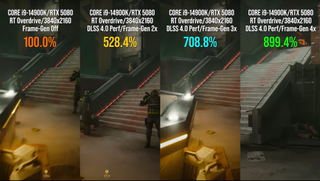Nvidia‘s reveal of the RTX 5000 series lineup has come with the expected painful price tag for the flagship RTX 5090 – but with DLSS 4 and Frame Generation, its little brother the RTX 5080 looks set to be a powerhouse in demanding games like Cyberpunk 2077.
Highlighted byDigital Foundry’s Cyberpunk 2077 analysis on the RTX 5080, CD Projekt Red’s 2020 mega-hit runs above 120fps at a 4K resolution with full path tracing enabled using DLSS 4 and Frame Generation. This figure had to be extrapolated by Digital Foundry, as the footage doesn’t show an actual framerate but rather the progressive percentage boosts to the base framerate with two, three, and four generated frames being inserted between each rendered frame.
While it’s yet to be seen whether this generational performance boost over the RTX 4080 mostly stems from the RTX 5080’s raw performance capabilities or DLSS 4’s new Multi Frame Generation feature, it’s good news for both RTX 5000 and 4000 series owners with access to DLSS 4 and Frame Generation (despite the additional latency, even with the new Reflex 2 feature for lower latency) – but it could spell trouble for the optimization for future PC ports.

DLSS 4 and Frame Generation is great, but I’m very concerned about optimization for future PC ports
First and foremost, I must point out that Cyberpunk 2077‘s full path tracing mode is an incredibly demanding benchmark for any graphics card (even the likes of the RTX 5080 and 5090), as it is with other games such as Alan Wake 2. Nvidia’s DLSS upscaling method and Frame Generation are necessary tools to maintain higher frame rates when trying to run these games at maximum graphical settings and high resolutions.
The problem here doesn’t lie specifically with the high GPU demand for path tracing, but rather the reliance on DLSS and Frame Generation that some game developers are now seemingly accepting – it’s no secret that PC ports have been a mess for a long while now, with upscaling features like DLSS and AMD’s rival FSR standing as a clumsy band-aid for poorly optimized games.
Acknowledging the major advantages that come with the new Multi Frame Generation (which is exclusive to the RTX 5000 series), and DLSS 4 coming to all RTX GPU users, I fear that game developers may no longer have the incentive to optimize games properly for PC. While it’s easy to think that AI-generated frames in-game are great for all scenarios, caveats like increased input latency and ghosting suggest otherwise.
It’s abundantly clear that the near future of gaming will be driven by AI using tools like AMD’s FSR or Nvidia’s DLSS, so we can only hope that this won’t lead to developers leaving game optimization as a secondary priority.
After all, the majority of PC gamers are still using RTX 3000 or older GPUs that lack access to any sort of frame-gen tech; according to the most recent Steam Hardware Survey, only three of the top ten most popular GPUs are RTX 4000 models, with the GTX 1650 still sitting in the number four position – a card that doesn’t even have access to DLSS upscaling at all, let alone Frame Generation. As in-game textures and models become more bloated and devs turn to AI-powered upscaling to help salve performance, gamers who can’t afford to upgrade are in danger of being left behind…